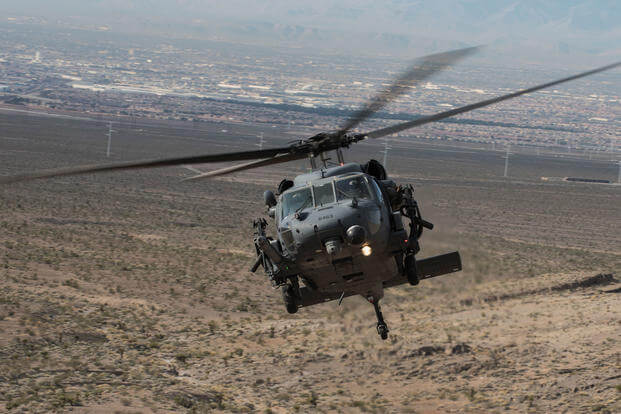A U.S. Air Force HH-60 Pave Hawk slammed into a steel cable in western Iraq in March, causing the helicopter to tangle and crash, killing all seven airmen on board, according to a new investigation report.
An Accident Investigation Board report released Monday says the Pave Hawk, assigned to the 332nd Air Expeditionary Wing, was part of a two-aircraft formation flying toward Al Qaim, Iraq, on March 15. The mission objective was to position a helicopter landing zone closer to ground operations, according to the document.
During the flight, the formation refueled from an HC-130 King recovery aircraft. Then, roughly 40 minutes into the night operation, for which "night illumination for the flight was low," the mishap Pave Hawk, flying in the lead, overshot its targeted landing area, the report states.
It was too dark for night-vision goggles to detect the cables.
Related Content:
- Airmen Killed in Iraq Helicopter Crash Were from 3 Rescue Units
- As Tempo Rises, Most Active Reserve Rescue Unit Wants New Aircraft
- Thunderbirds Pilot Lost Consciousness Before Fatal Crash, Air Force Says
The HH-60G "erroneously overflew the intended [helicopter landing zone] and descended to low altitude," the report states. "As a result, the aircraft descended into an unplanned location, striking a 3/8-inch diameter galvanized steel cable strung horizontally between two 341-foot-high towers."
Images within the report show the cables to be part of a powerline structure. The towers were roughly 1,000 yards apart.
The co-pilot turned left to avoid one of the towers. But a helicopter blade "struck the second of four" of the 3/8 inch cables, the report said. "The cable quickly entangled in the HH-60G's main rotor assembly, resulting in catastrophic damage and an unflyable condition."
The investigation, conducted by Brig. Gen. Bryan P. Radliff, concluded the pilot "misinterpreted aircraft navigation displays," causing the formation to overfly the intended destination.
Communication on the helicopter's route and scheduled waypoints was never resolved between the crew and a Joint Terminal Attack Controller on the ground, Radliff said.
"The [mishap pilot] was interrupted multiple times during his navigation duties, including communications with the [mishap wingmen] regarding landing zone plan changes and [mishap crew] requests for prelanding power calculations and JTAC information requests," the report states.
The conversation continued as the JTAC reiterated that there were towers in the area, but the Pave Hawk was already slightly northeast of the designated landing spot, according to an illustrated diagram in the accident report.
Follow-on waypoints had been incorporated into flight plan as backups should the formation need to divert and land elsewhere. The report says those waypoints could have been the reason the pilot began flying slightly farther north than planned.
The helicopter was traveling at an estimated 125 knots, or about 144 miles per hour, at an altitude between 250 and 270 feet above ground level.
Having witnessed the crash and the illumination from the helicopter's impact, the second aircraft was able to spot the cables and divert. The second crew called in search-and-rescue forces immediately, the report said.
Radliff said limited visibility also contributed to the crash. Current HH-60G "tactics, techniques and procedures contain a warning stating, 'electric power lines, unlit towers, poles, antennas, dead trees, and all types of wires are extremely difficult to see while conducting NVG operations,' " the report states.
The Pave Hawk has a "wire strike protection system" in an effort to prevent such accidents. Radliff said the post-crash analysis determined "it was not effective because it does not appear that the cable had the opportunity to be pulled through any of the WSPS wire cutters."
Killed in the crash were: Master Sgt. Christopher J. Raguso, 39, a special missions aviation flight engineer; Capt. Andreas B. O'Keeffe, 37, an HH-60G pilot; Capt. Christopher T. Zanetis, 37, an HH-60G pilot; and Staff Sgt. Dashan J. Briggs, 30, a special missions aviation flight engineer, all of whom belonged to the 106th Rescue Wing at Francis S. Gabreski Air National Guard Base, according to a Saturday news release. The rescue wing is based on Long Island.
Master Sgt. William R. Posch, 36, of Indialantic, Florida, and Staff Sgt. Carl P. Enis, 31, of Tallahassee, Florida, belonged to the 308th Rescue Squadron at Patrick Air Force Base, Florida. The squadron, known as an Air Force's "Guardian Angel" personnel and recovery unit, is part of the Air Force Reserve's 920th Rescue Wing.
Also killed was Capt. Mark K. Weber, 29, of Colorado Springs, Colorado. Weber was assigned to the 38th Rescue Squadron at Moody Air Force Base, Georgia.
The HH-60 is known as the backbone of combat search-and-rescue operations. It is a variant of the Army's Black Hawk helicopter, used to conduct personnel recovery and medical recovery missions. The crew is normally composed of two pilots, one flight engineer and one gunner.
The aging HH-60G Pave Hawk fleet is expected to be replaced within the next decade by the Sikorsky HH-60W, the latest combat rescue helicopter based on the UH-60M Black Hawk.
-- Oriana Pawlyk can be reached at oriana.pawlyk@military.com. Follow her on Twitter at @Oriana0214.













